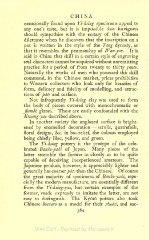Page 446 - Oriental Series Japan and China, Brinkly
P. 446
CHINA
occasionally found upon Ti-hsing specimens appeal to
any one's taste, but it is impossible that foreigners
should sympathise with the ecstasy of the Chinese
dilettante when he discovers that the inscription on a
pot is written in the style of the Tang dynasty, or
that it resembles the penmanship of Wan-yen. It is
said in China that skill in a certain style of engraving
seal-characters cannot be acquired without unremitting
practise for a period of from twenty to thirty years.
Naturally the works of men who possessed this skill
command, in the Chinese market, prices prohibitive
to Western collectors who look only for beauties of
form, delicacy and fidelity of modelling, and attrac-
tions of pate and surface.
Not infrequently Ti-hsing clay was used to form
the body of pieces covered with monochromatic or
flambe glazes. These are easily confounded with the
Kivang-yao described above.
In another variety the unglazed surface is bright-
ened by enamelled decoration scrolls, quatrefoils,
floral designs, &c. in bas-relief, the colours employed
being chiefly lilac, yellow, and green.
The Ti-hsing pottery is the protype of the cele-
brated Eanko-yaki of Japan. Many pieces of the
latter resemble the former so closely as to be quite
capable of deceiving inexperienced amateurs. The
Japanese product, however, is appreciably lighter and
generally has coarser pate than the Chinese. Of course
the great majority of specimens of Banko-yaki, espe-
cially the modern manufacture, are essentially different
from the Ti-hsing-yao, but certain examples of the
former, made expressly to imitate the latter, are not
easy to distinguish. The Kyoto potters also took
Chinese boccaro as a model for their shudei, and suc-
3 64

